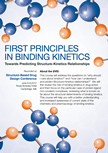2013 Archived Content
CONFERENCE SERIES: Drug Discovery & Development
Recorded at: Structure-Based Drug Design

 About this Product:
About this Product:
This course will address the questions on “why should I care about kinetics?” and “how can I understand and predict Structure-Kinetics relationships?” We will first review the role of binding kinetics in drug action and then focus on the particular case of protein-ligand non-covalent complexes, reviewing what is known so far about the structural determinants of binding kinetics. This course will help you with a better understanding and increased awareness of current state of the chemistry and pharmacology of binding kinetics.
About this Product:
2 Presentations
57 Slides
Over 87 Minutes
Individual: $345
Site License: $1380
Agenda At A Glance:
Part 1. Introduction to binding kinetics
- What are binding kinetics?
- First principles - kinetics and thermodynamics
- Why are binding kinetics important? What is the value to you and drug discovery?
Part 2. Binding kinetic methodologies
- Technologies (strengths and weakness)
- Label-free Biosensors SPR
- Radioligand binding
- Slow-binding enzyme kinetics
- Determining kinetic mechanism and rates
- One-step vs. two- step mechanisms
- Association and dissociation rates
- Interpretation of binding kinetics.
- What do the experimentally determined kinetic constants mean?
- Rate-limiting steps
- Competing rates
- Practical example
Part 3. Binding at the molecular level
- Binding processes: what do they look like at the molecular level?
- Computational approaches
- Examples
- Microscopic vs. macroscopic constants
Part 4. Structural determinants of binding kinetics
- Structural elements that increase on-rates and rebinding
- Trapping mechanisms to decrease off-rates
- Binding coupled to rare events: slow on- and off- rates
Speaker Biographies:
 Dr. Swinney has devoted the majority of his career to the identification of effective mechanisms of drug action, promising leads and clinical candidates to address unmet medical needs. He has also developed an expertise in the understanding and application of binding kinetics to drug discovery. Dr. Swinney has a PhD in medicinal chemistry from the University of Washington, Seattle, over 20 years of industrial experience (Roche, Syntex) and is currently CEO and co-founder of the non-profit, Institute for Rare and Neglected Diseases Drug Discovery (iRND3, www.irnd3.org).
Dr. Swinney has devoted the majority of his career to the identification of effective mechanisms of drug action, promising leads and clinical candidates to address unmet medical needs. He has also developed an expertise in the understanding and application of binding kinetics to drug discovery. Dr. Swinney has a PhD in medicinal chemistry from the University of Washington, Seattle, over 20 years of industrial experience (Roche, Syntex) and is currently CEO and co-founder of the non-profit, Institute for Rare and Neglected Diseases Drug Discovery (iRND3, www.irnd3.org).
 Xavier Barril is an ICREA Research Professor at Barcelona University’s School of Pharmacy. In 2001 he earned his Ph. D. from the University of Barcelona (Spain) for theoretical studies on the ligand-receptor molecular recognition process. He then joined the Applications Modelling team at Vernalis (Cambridge, UK). In his role as Molecular Modeller he was involved in a range of projects, mainly in the oncology area, including the discovery and optimization of Hsp90 inhibitors currently in clinical trials. In 2004 he was promoted to Senior Scientist. In October 2005 he was appointed ICREA Research Professor and moved back to academia. His main research interests are the chemical validation of new therapeutic targets, the integration of experimental and computational methods for drug design and the development of computational chemistry techniques. He has co-authored more than 40 publications, including research papers, reviews and book chapters, as well as a number of patents.
Xavier Barril is an ICREA Research Professor at Barcelona University’s School of Pharmacy. In 2001 he earned his Ph. D. from the University of Barcelona (Spain) for theoretical studies on the ligand-receptor molecular recognition process. He then joined the Applications Modelling team at Vernalis (Cambridge, UK). In his role as Molecular Modeller he was involved in a range of projects, mainly in the oncology area, including the discovery and optimization of Hsp90 inhibitors currently in clinical trials. In 2004 he was promoted to Senior Scientist. In October 2005 he was appointed ICREA Research Professor and moved back to academia. His main research interests are the chemical validation of new therapeutic targets, the integration of experimental and computational methods for drug design and the development of computational chemistry techniques. He has co-authored more than 40 publications, including research papers, reviews and book chapters, as well as a number of patents.
About the Conference:
Structure-based drug design took nearly two decades of multiple, parallel technological improvements to arrive at its current mainstream position in medicinal chemistry. Developments in computer graphics, high-power radiation sources, computational processing power, refinement protocols, virtual screening and crystallography were all necessary to create the environment for rapid, iterative structure-based drug discovery. Given the crisis facing the pharmaceutical industry in the translation of early stage drug discovery results, a different set of tools, concerned with algorithms and methods for developing best in class drugs that engage biological targets with kinetically optimized potency and selectivity will need to be refined. In this conference, we bring to focus recent advancements in this field from an experienced faculty.